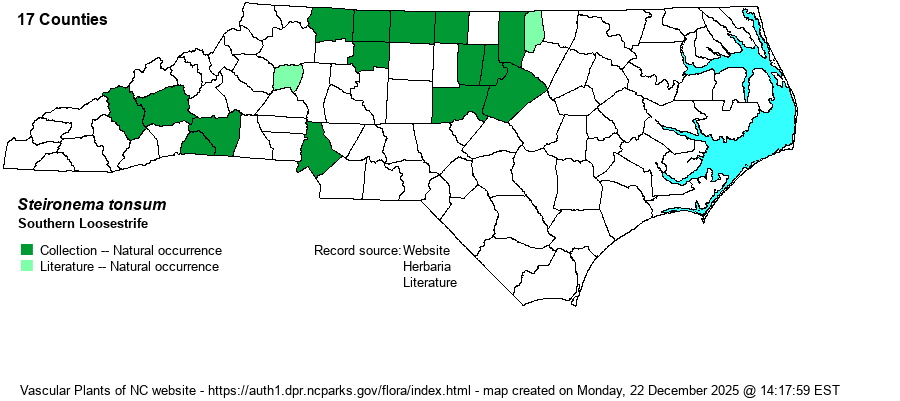| Author | (Alph. Wood) E.P. Bicknell ex Britton. | |
| Distribution | Primarily in the Piedmont, and within that province, mainly in the northern third, south to Wake, Chatham, Forsyth, and Surry counties. Widely scattered elsewhere in the Piedmont, and in just two Mountain counties (Buncombe, Haywood).
This species has a limited range in the Mid-South, ranging from southern VA, WV, and KY south only to northern SC and central AL. | |
| Abundance | Rare to locally uncommon in the northern Piedmont; very rare to rare in the central and southwestern Piedmont; extremely rare in the central Mountains. This is a Significantly Rare species, as designated by the NCNHP. | |
| Habitat | This is an upland species, growing on thin soil, either with rock close to the surface or on a hardpan; it prefers somewhat high pH soil, but a few sites are on slightly acidic soils. It grows along roadbanks, wooded borders, open upland woods, glades and barrens, near rock outcrops, and other dry to somewhat mesic sites in partial sun/shade. | |
| Phenology | Blooms from May to July, and fruits from August to October. | |
| Identification | This scarce plant can be easily confused as the common S. ciliatum, and many a biologist has probably overlooked it as that species and failed to stop and notice these plants. It grows to about 2 feet tall with an erect stem, with a few short branches from upper axils. The leaves are similar to that species, with several pairs of opposite leaves; however, in this species the petiole is rather long (up to 1-inch long) but is strictly glabrous; S. ciliatum has strongly hairy petioles, and this distinction is easily noted. The leaf blades are lanceolate to ovate, about 2-3 inches long and about 1/3 as wide, entire on the margin, rounded to the petiole, and tapered to the tip. It has yellow flowers (about 3/4-inch across) from the upper leaf axils, as in S. ciliatum, but in S. tonsa the inflorescence tends to be either less floriferous (fewer flowers) or is more open, with longer pedicels. This distinction can be somewhat obvious to biologists with experience with both species, but you always must check the petioles for hairiness to be sure. Normally, habitat is the first clue to the identify, as S. tonsum is a species of dry to somewhat mesic soil of uplands, whereas S. ciliatum is usually found in wetlands or lower and moist slopes. Though RAB (1968) say this species can be "locally abundant", this is seldom the case now, though as with others in the genus, it can grow in stands of 50-100 plants or more. | |
| Taxonomic Comments | None, though a few old references used the name of "S. intermedium" for it.
Weakley (2020) has split out Steironema from Lysimachia based on a 2018 paper using molecular research; and in so doing has gone back to "old" taxonomy. In Lysimachia there are no staminodes and the leaves are punctate with elongate markings (vs. staminodes present and punctae absent in Steironema). | |
| Other Common Name(s) | Appalachian Loosestrife, Southern Yellow Loosestrife | |
| State Rank | S2 | |
| Global Rank | G4 | |
| State Status | SR-P | |
| US Status | | |
| USACE-agcp | | |
| USACE-emp | | |

